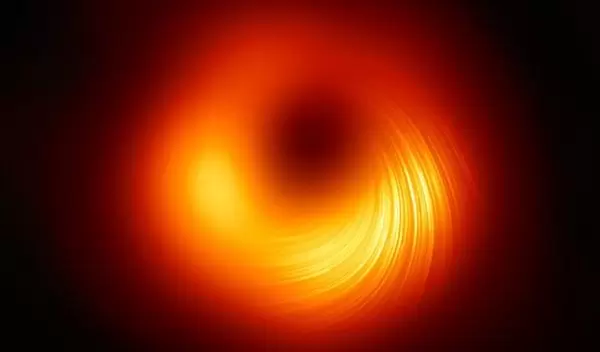
Scientists image magnetic fields at edge of M87's black hole
Event Horizon Telescope scientists, who produced the first image of a black hole, have revealed a new view of the massive object at the center of the M87 galaxy, showing how it looks in polarized light.
It's the first time astronomers have been able to measure polarization, a signature of magnetic fields, this close to the edge of a black hole. The observations are key to explaining how the M87 galaxy, located 55 million light-years away, can launch energetic jets from its core.
"We are now seeing the next crucial piece of evidence to understand how magnetic fields behave around black holes and how activity in this very compact region of space can drive powerful jets that extend far beyond the galaxy," says Monika Mościbrodzka of Radboud University in the Netherlands, coordinator of the EHT Polarimetry Working Group.
On April 10, 2019, scientists released the first image of a black hole, revealing a bright ringlike structure with a dark central region -- the black hole's shadow. Since then, the EHT scientists have delved deeper into the data on the supermassive object at the heart of the M87 galaxy, finding that a significant fraction of the light around the M87 black hole is polarized.
"The polarization of light carries information that allows us to better understand the physics behind the image we saw in April 2019," explains Jason Dexter of the University of Colorado Boulder, and a member of the EHT collaboration.
Light becomes polarized when it goes through certain filters, such as the lenses of polarized sunglasses, or when it is emitted in hot regions of space that are magnetized. Just as polarized sunglasses help us see better by reducing reflections and glare from bright surfaces, astronomers can sharpen their vision of the region around the black hole by looking at how the light being emitted is polarized. Polarization allows astronomers to map the magnetic field lines at the inner edge of the black hole.
"The newly published polarized images are key to understanding the powerful jets that are launched from this region," says EHT collaboration member Andrew Chael of the Princeton Center for Theoretical Sciences and the Princeton Gravity Initiative.
The bright jets of energy and matter that emerge from M87's core and extend at least 5,000 light-years from its center are among the galaxy's most mysterious and energetic features. Most matter lying close to the edge of a black hole falls in. However, some of M87's surrounding particles escape moments before capture and are blown far out into space in the form of jets.
The research is funded in part by the U.S. National Science Foundation, and is reported in The Astrophysical Journal.


